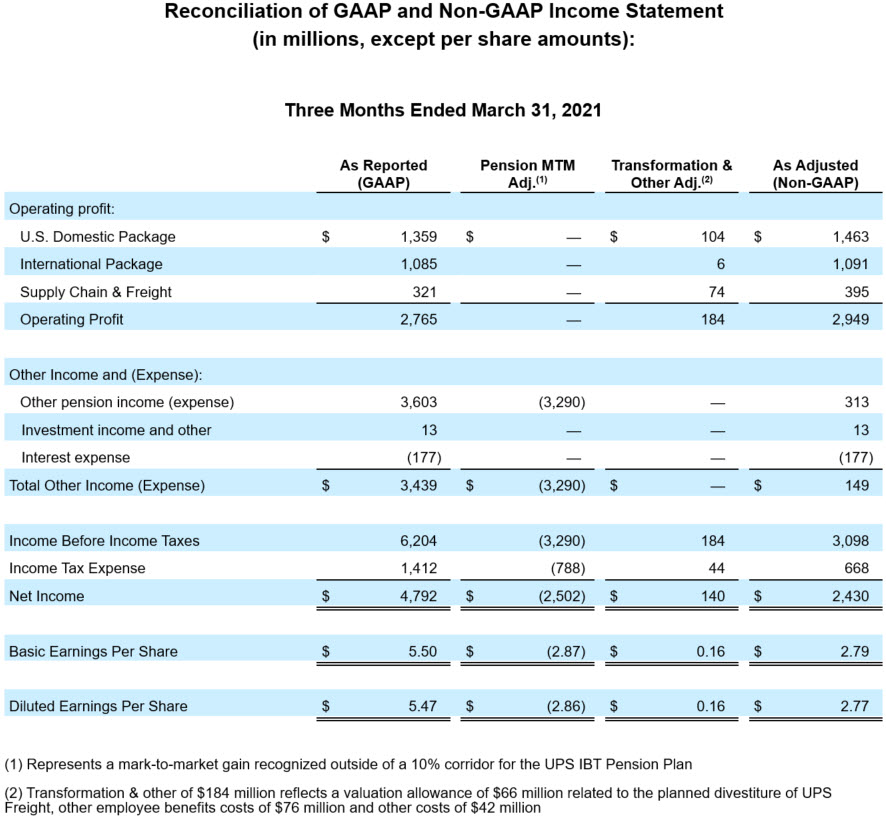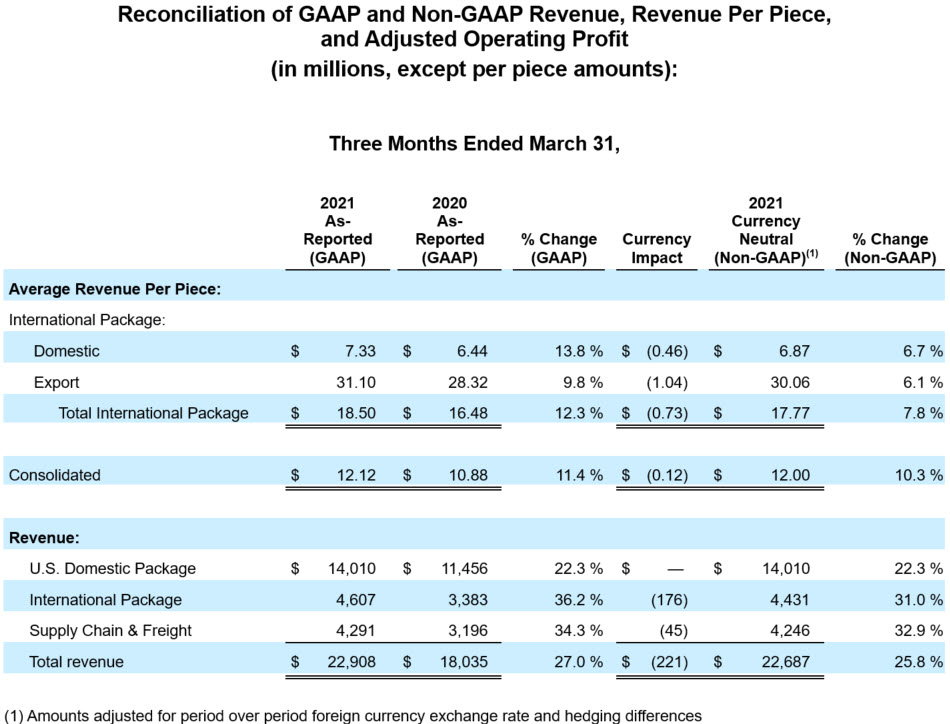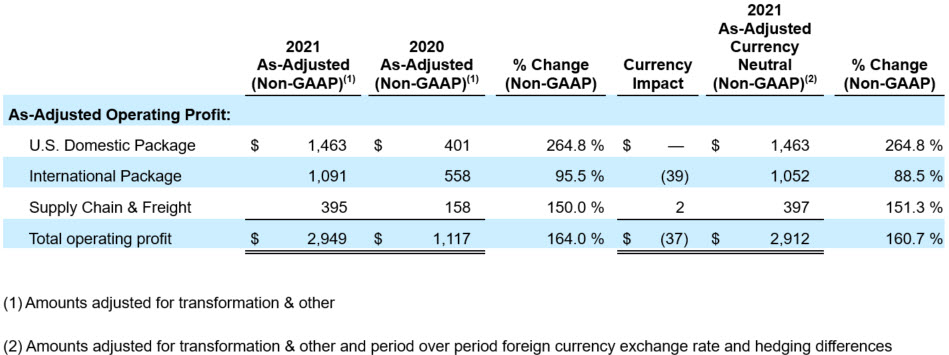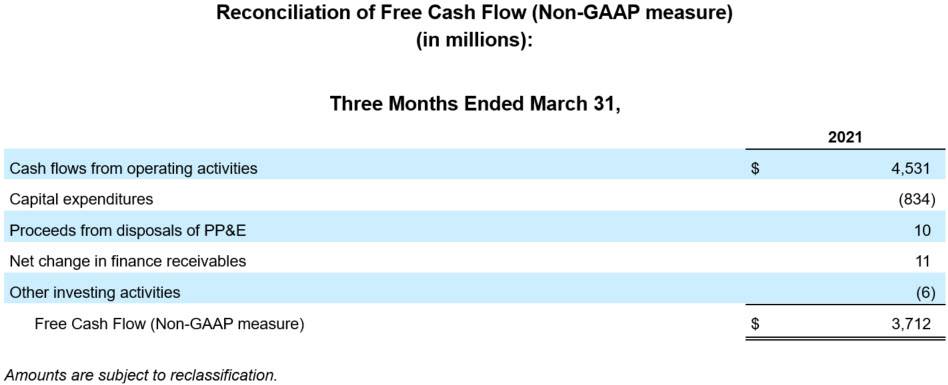ATLANTA
- Consolidated Revenue Increased 27%; Growth Across All Segments
- Consolidated Operating Profit Up 158% to $2.8B, Up 164% on an Adjusted* Basis
- Diluted EPS of $5.47; Adjusted Diluted EPS Up 141% to $2.77
UPS (NYSE:UPS) today announced first-quarter 2021 consolidated revenue of $22.9 billion, a 27% increase over the first quarter of 2020. Consolidated average daily volume increased 14.3% year over year. Consolidated operating profit was $2.8 billion, up 158% compared to the first quarter of 2020, and up 164% on an adjusted basis. Diluted earnings per share were $5.47 for the quarter, 393% above the same period in 2020, and up 141% on an adjusted basis.
For the first-quarter of 2021, GAAP results include a net benefit of $2.4 billion, or $2.70 per diluted share, comprised of an after-tax mark-to-market (MTM) pension benefit of $2.5 billion and after-tax transformation and other charges of $140 million. The MTM benefit was primarily driven by the enactment of the American Rescue Plan Act of 2021 (ARPA). The ARPA, which was signed into law on March 11, 2021, protects certain multi-employer pension plans from becoming insolvent through 2051, thereby eliminating the Company’s liability for potential coordinating benefits related to the Central States Pension Fund. Enactment of the ARPA required the Company to remeasure its UPS IBT Pension plan at current discount rates, which have increased since the previous measurement date. The overall result was a reduction in the pension liability of $6.4 billion.
“I want to thank all UPSers for delivering what matters, including COVID-19 vaccines,” said Carol Tomé, UPS chief executive officer. “During the quarter, we continued to execute our strategy under the better not bigger framework, which enabled us to win the best opportunities in the market and drove record financial results.”
U.S. Domestic Segment
|
1Q 2021 | Adjusted 1Q 2021 |
1Q 2020 | Adjusted 1Q 2020 |
Revenue | $14,010 M |
| $11,456 M |
|
Operating profit | $1,359 M | $1,463 M | $364 M | $401 M |
- Revenue increased 22.3%, led by growth from small and medium-sized businesses.
- Revenue per piece increased 10.2%, driven by Ground products.
- Operating margin was 9.7%; adjusted operating margin was 10.4%.
International Segment
|
1Q 2021 | Adjusted 1Q 2021 |
1Q 2020 | Adjusted 1Q 2020 |
Revenue | $4,607 M |
| $3,383 M |
|
Operating profit | $1,085 M | $1,091 M | $551 M | $558 M |
- Average daily volume grew 23.1%, with export growth from all regions.
- Revenue increased 36.2%, led by Asia and Europe.
- Operating margin was 23.6%; adjusted operating margin was 23.7%.
Supply Chain and Freight Segment
|
1Q 2021 | Adjusted 1Q 2021 |
1Q 2020 | Adjusted 1Q 2020 |
Revenue | $4,291 M |
| $3,196 M |
|
Operating profit | $321 M | $395 M | $157 M | $158 M |
- Revenue increased 34.3%, driven by strong demand in nearly all businesses.
- Operating margin was 7.5%; adjusted operating margin was 9.2%.
* “Adjusted” amounts are non-GAAP financial measures. See the appendix to this release for a discussion of non-GAAP financial measures, including a reconciliation to the most closely correlated GAAP measure.
Outlook
Given continued economic uncertainty, the Company is not providing 2021 revenue or diluted earnings per share guidance; however, it is re-affirming its full-year capital allocation plans. UPS has scheduled its 2021 Investor and Analyst Day for June 9, when it will share further financial details.
Reaffirms Full-Year 2021 Capital Allocation Plans
- The sale of UPS Freight is expected to close in the second quarter.
- Capital expenditures are planned to be about $4.0 billion.
- Long-term debt repayments, including $1.5 billion repaid in the first quarter of 2021, will total $2.5 billion.
- Effective tax rate for the remainder of the year is expected to be around 23.5%.
- The Company has no plans to repurchase shares.
Contacts:
UPS Media Relations: 404-828-7123 or pr@ups.com
UPS Investor Relations: 404-828-6059 (option 2) or investor@ups.com
# # #
Conference Call Information
UPS CEO Carol Tomé and CFO Brian Newman will discuss first-quarter results with investors and analysts during a conference call at 8:30 a.m. ET, April 27, 2021. That call will be open to others through a live Webcast. To access the call, go to www.investors.ups.com and click on “Earnings Webcast.” Additional financial information is included in the detailed financial schedules being posted on www.investors.ups.com under “Financials” and as filed with the SEC as an exhibit to our Current Report on Form 8-K.
About UPS
UPS (NYSE: UPS) is one of the world’s largest package delivery companies with 2020 revenue of $84.6 billion, and provides a broad range of integrated logistics solutions for customers in more than 220 countries and territories. The company’s more than 540,000 employees embrace a strategy that is simply stated and powerfully executed: Customer First. People Led. Innovation Driven. UPS is committed to being a steward of the environment and positively contributing to the communities we serve around the world. UPS also takes a strong and unwavering stance in support of diversity, equity and inclusion. The company can be found on the Internet at www.ups.com, with more information at www.investors.ups.com.
Forward-Looking Statements
This release and our filings with the Securities and Exchange Commission contain and in the future may contain “forward-looking statements” within the meaning of the Private Securities Litigation Reform Act of 1995. Statements other than those of current or historical fact, and all statements accompanied by terms such as “will,” “believe,” “project,” “expect,” “estimate,” “assume,” “intend,” “anticipate,” “target,” “plan,” and similar terms, are intended to be forward-looking statements. Forward-looking statements are made subject to the safe harbor provisions of the federal securities laws pursuant to Section 27A of the Securities Act of 1933 and Section 21E of the Securities Exchange Act of 1934.
From time to time, we also include written or oral forward-looking statements in other publicly disclosed materials. Such statements may relate to our intent, belief and current expectations about our strategic direction, prospects and future results, and give our current expectations or forecasts of future events; they do not relate strictly to historical or current facts. Management believes that these forward-looking statements are reasonable as and when made. However, caution should be taken not to place undue reliance on any forward-looking statements because such statements speak only as of the date when made.
Forward-looking statements are subject to certain risks and uncertainties that could cause actual results to differ materially from our historical experience and our present expectations or anticipated results. These risks and uncertainties, include, but are not limited to: continued uncertainties related to the impact of the COVID-19 pandemic on our business and operations, financial performance and liquidity, our customers and suppliers, and on the global economy; changes in general economic conditions, in the U.S. or internationally; significant competition on a local, regional, national and international basis; changes in our relationships with our significant customers; changes in the regulatory environment in the U.S. or internationally; increased or more complex physical or data security requirements; legal, regulatory or market responses to global climate change; results of negotiations and ratifications of labor contracts; strikes, work stoppages or slowdowns by our employees; the effects of changing prices of energy, including gasoline, diesel and jet fuel, and interruptions in supplies of these commodities; changes in exchange rates or interest rates; uncertainty from the expected discontinuance of LIBOR and transition to any other interest rate benchmark; our ability to maintain our brand image; our ability to attract and retain qualified employees; breaches in data security; disruptions to the Internet or our technology infrastructure; interruptions in or impacts on our business from natural or man-made events or disasters including terrorist attacks, epidemics or pandemics; our ability to accurately forecast our future capital investment needs; exposure to changing economic, political and social developments in international and emerging markets; changes in business strategy, government regulations, or economic or market conditions that may result in impairment of our assets; increases in our expenses or funding obligations relating to employee health, retiree health and/or pension benefits; potential additional U.S. or international tax liabilities; potential claims or litigation related to labor and employment, personal injury, property damage, business practices, environmental liability and other matters; our ability to realize the anticipated benefits from acquisitions, dispositions, joint ventures or strategic alliances; our ability to realize the anticipated benefits from our transformation initiatives; cyclical and seasonal fluctuations in our operating results; our ability to manage insurance and claims expenses; and other risks discussed in our filings with the Securities and Exchange Commission from time to time, including our Annual Report on Form 10-K for the year ended December 31, 2020 and subsequently filed reports. You should consider the limitations on, and risks associated with, forward-looking statements and not unduly rely on the accuracy of predictions contained in such forward-looking statements. We do not undertake any obligation to update forward-looking statements to reflect events, circumstances, changes in expectations, or the occurrence of unanticipated events after the date of those statements.
Reconciliation of GAAP and non-GAAP Financial Measures
We supplement the reporting of our financial information determined under generally accepted accounting principles ("GAAP") with certain non-GAAP financial measures, including "adjusted" compensation and benefits, operating expenses, operating profit, operating margin, other income and (expense), income before income taxes, income tax expense, effective tax rate, net income and earnings per share. We supplement the reporting of revenue, revenue per piece and operating profit with adjusted measures that exclude the period over period impact of foreign currency exchange rate changes and hedging activities, and we disclose free cash flow. The equivalent measures determined in accordance with GAAP are also referred to as "reported" or "unadjusted.”
We believe that these non-GAAP measures provide additional meaningful information to assist users of our financial statements in understanding our financial results and cash flows and assessing our ongoing performance, because they exclude items that may not be indicative of, or are unrelated to, our underlying operations and may provide a useful baseline for analyzing trends in our underlying businesses. These non-GAAP measures are used internally by management for business unit operating performance analysis, business unit resource allocation and in connection with incentive compensation award determinations.
Restructuring and Other Charges
Adjusted operating profit, operating margin, income before income taxes, net income and earnings per share exclude the impact of charges related to restructuring programs, including Transformation strategy costs and asset impairments.
Impact of Changes in Foreign Currency Exchange Rates and Hedging Activities
Currency-neutral revenue, revenue per piece and operating profit are calculated by dividing current period reported U.S. dollar revenue, revenue per piece and operating profit by the current period average exchange rates to derive current period local currency revenue, revenue per piece and operating profit. The derived amounts are then multiplied by the average foreign exchange rates used to translate the comparable results for each month in the prior year period (including the period over period impact of foreign currency hedging activities). The difference between the current period reported U.S. dollar revenue, revenue per piece and operating profit and the derived current period U.S. dollar revenue, revenue per piece and operating profit is the period over period impact of currency fluctuations.
Mark-To-Market Pension and Postretirement Adjustments
We recognize changes in the fair value of plan assets and net actuarial gains and losses in excess of a 10% corridor for our pension and postretirement defined benefit plans immediately as part of other pension income (expense). We supplement the presentation of our income before income taxes, net income and earnings per share with non-GAAP measures that exclude the impact of gains and losses recognized in excess of the 10% corridor and the related income tax effects. We believe excluding these mark-to-market impacts provides important supplemental information by removing the volatility associated with short-term changes in market interest rates, equity values, and similar factors.
The deferred income tax effects of mark-to-market pension and postretirement adjustments are calculated by multiplying the statutory tax rates applicable in each tax jurisdiction, including the U.S. federal jurisdiction and various U.S. state and non-U.S. jurisdictions, by the adjustments.
Free Cash Flow
We calculate free cash flow as cash flows from operating activities less capital expenditures, proceeds from disposals of property, plant and equipment, and plus or minus the net changes in finance receivables and other investing activities. We believe free cash flow is an important indicator of how much cash is generated by regular business operations and we use this as a measure of incremental cash available to invest in our business, meet our debt obligations and return cash to shareowners.
Non-GAAP financial measures should be considered in addition to, and not as an alternative for, our reported results prepared in accordance with GAAP. Our adjusted financial information does not represent a comprehensive basis of accounting. Therefore, our adjusted financial information may not be comparable to similarly titled information reported by other companies.






